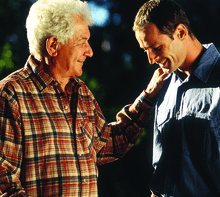Interaction
Interaction is a kind of action that occurs as two or more objects have an effect upon one another. The idea of a two-way effect is essential in the concept of interaction, as opposed to a one-way causal effect. Closely related terms are interactivity and interconnectivity, of which the latter deals with the interactions of interactions within systems: combinations of many simple interactions can lead to surprising emergent phenomena. Interaction has different tailored meanings in various sciences. Changes can also involve interaction.
| Communication |
|---|
| Portal · History |
| General aspects |
| Fields |
| Disciplines |
| Categories |

Casual examples of interaction outside science include:
- Communication of any sort, for example two or more people talking to each other, or communication among groups, organizations, nations or states: trade, migration, foreign relations, transportation.
- The feedback during the operation of a machine such as a computer or tool, for example the interaction between a driver and the position of his or her car on the road: by steering the driver influences this position, by observation this information returns to the driver.
Physics
In physics, a fundamental interaction (depending on the nature of the interaction, it might also be called a fundamental force) is a process by which elementary particles interact with each other. An interaction is often described as a physical field, and is mediated by the exchange of gauge bosons between particles. For example, the interaction of charged particles takes place through the mediation of electromagnetic fields, whereas beta decay occurs by means of the weak interaction. An interaction is fundamental when it cannot be described in terms of other interactions. There are four known fundamental interactions in nature: The electromagnetic, strong, weak and gravitational interactions. The weak and electromagnetic interactions are unified in electroweak theory, which has been theoretically unified with the strong force in the standard model, but experimental results are yet to prove this.
Chemistry
Interactions between atoms and molecules:
Biochemistry
Molecular biology
In molecular biology, the knowledge on gene/protein interaction among themselves and with their metabolites is referred to as molecular pathways.
Medicine and pharmacology
In medicine, most medications can be safely used with other medicines, but particular combinations of medicines need to be monitored for interactions, often by the pharmacist. Interactions between medications fall generally into one of two main categories:
- pharmacodynamic : Involving the actions of the two interacting drugs.
- pharmacokinetic : Involving the absorption, distribution, metabolism, and excretion of one or both of the interacting drugs upon the other.
In terms of efficacy, there can be three types of interactions between medications: additive, synergistic, and antagonistic.
- Additive interaction means the effect of two chemicals is equal to the sum of the effect of the two chemicals taken separately. This is usually due to the two chemicals acting on the body via same or similar mechanism. Examples are aspirin and motrin, alcohol and depressant, tranquilizer and painkiller.
- Synergistic interaction means that the effect of two chemicals taken together is greater than the sum of their separate effect at the same doses. An example is pesticide and fertilizer.
- Antagonistic interaction means that the effect of two chemicals is actually less than the sum of the effect of the two drugs taken independently of each other. This is because the second chemical increases the excretion of the first, or even directly blocks its toxic actions. Antagonism forms the basis for antidotes of poisonings.
Biology and genetics
Geneticists work with a number of different genetic interaction modes to characterize how the combination of two mutations affect (or does not affect) the phenotype:[1] noninteractive, synthetic, asynthetic, suppressive, epistatic, conditional, additive, single-nonmonotonic and double-nonmonotonic. Further characterizations is enhancement interaction and nonadditive interaction. Biosemioticists investigate sign-mediated interactions within and between organisms that underlie syntactic, pragmatic and semantic rules.
The word epistasis is also used for genetic interaction in some contexts.
Communications
Sociology
In sociology, social interaction is a dynamic, changing sequence of social actions between individuals (or groups) who modify their actions and reactions due to the actions by their interaction partner(s). Social interactions can be differentiated into accidental, repeated, regular, and regulated. Social interactions form the basis of social relations.
Statistics
In statistics, an interaction is a term in a statistical model in which the effect of two, or more, variables is not simply additive.
An example from statistics applied to health science
If we were examining the effect of two variables, gender and premature birth, on health outcomes, we would describe any difference in health outcome scores between genders as a main effect. Similarly any difference in scores of full term/premature birth would be described as a main effect. The presence of an interaction effect implies that the effect of gender on health outcome varies as a function of premature birth status.
Computers
Media art
In media, interactivity is a feature of the media in question and as digital technology becomes more accessible to the masses interest in interactivity is increasing and becoming a cultural trend especially in the arts.
See also
- 63rd World Science Fiction Convention, the 63rd World Science Fiction Convention, held in Glasgow, Scotland, in 2005
- Financial transaction
- Game semantics
- Gordon Pask Conversation and Interactions of Actors Theory
- Interaction design
- Interaction design pattern
- Interaction frequency
- Interconnectivity
- Interface (communication studies)
- Reflection (physics)
References
- Becky L. Drees; Vesteinn Thorsson; Gregory W. Carter; Alexander W. Rives; Marisa Z. Raymond; Iliana Avila-Campillo; Paul Shannon; Timothy Galitski (2005). "Derivation of genetic interaction networks from quantitative phenotype data". Genome Biology. 6 (4): R38. doi:10.1186/gb-2005-6-4-r38. PMC 1088966. PMID 15833125.
External links
![]()